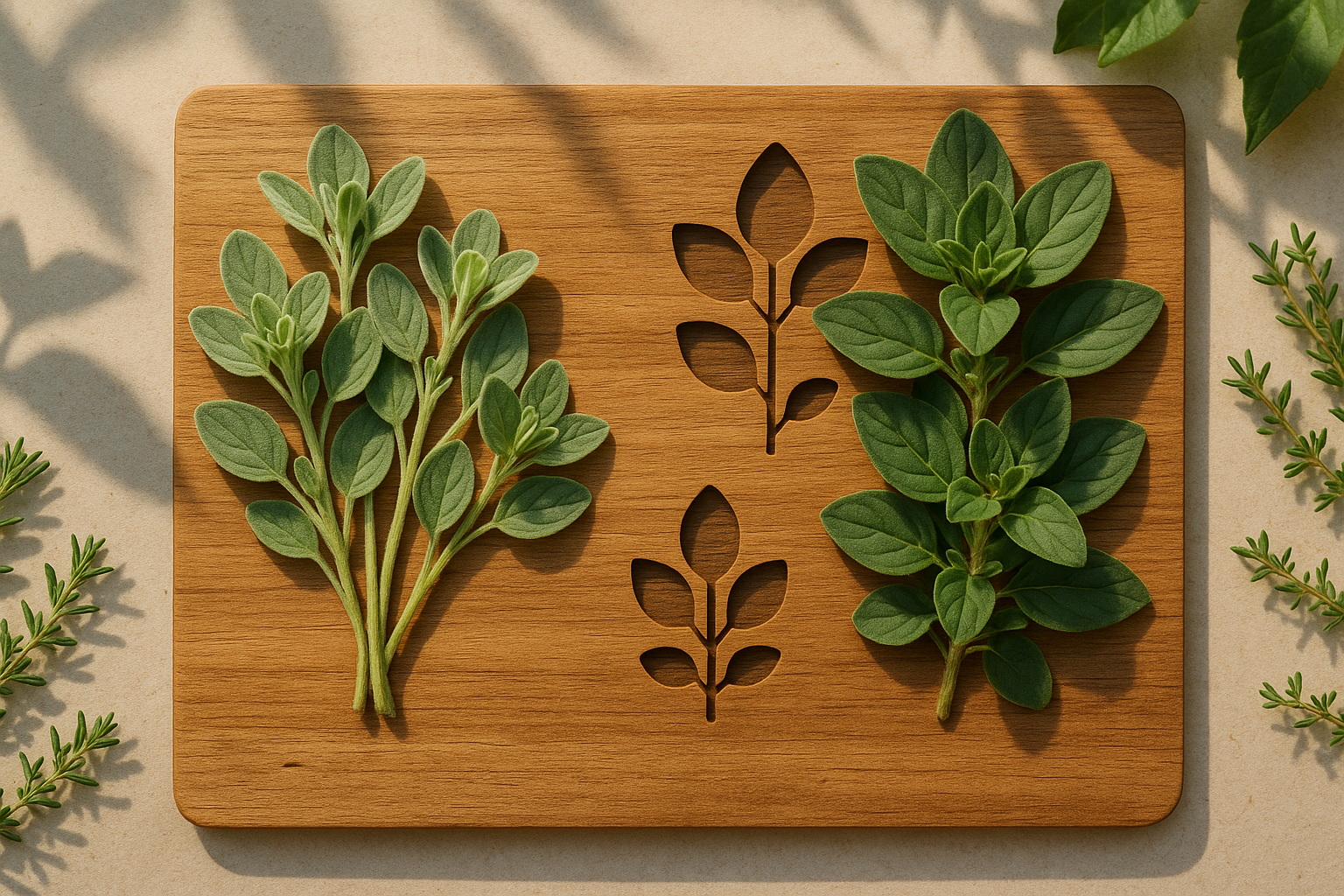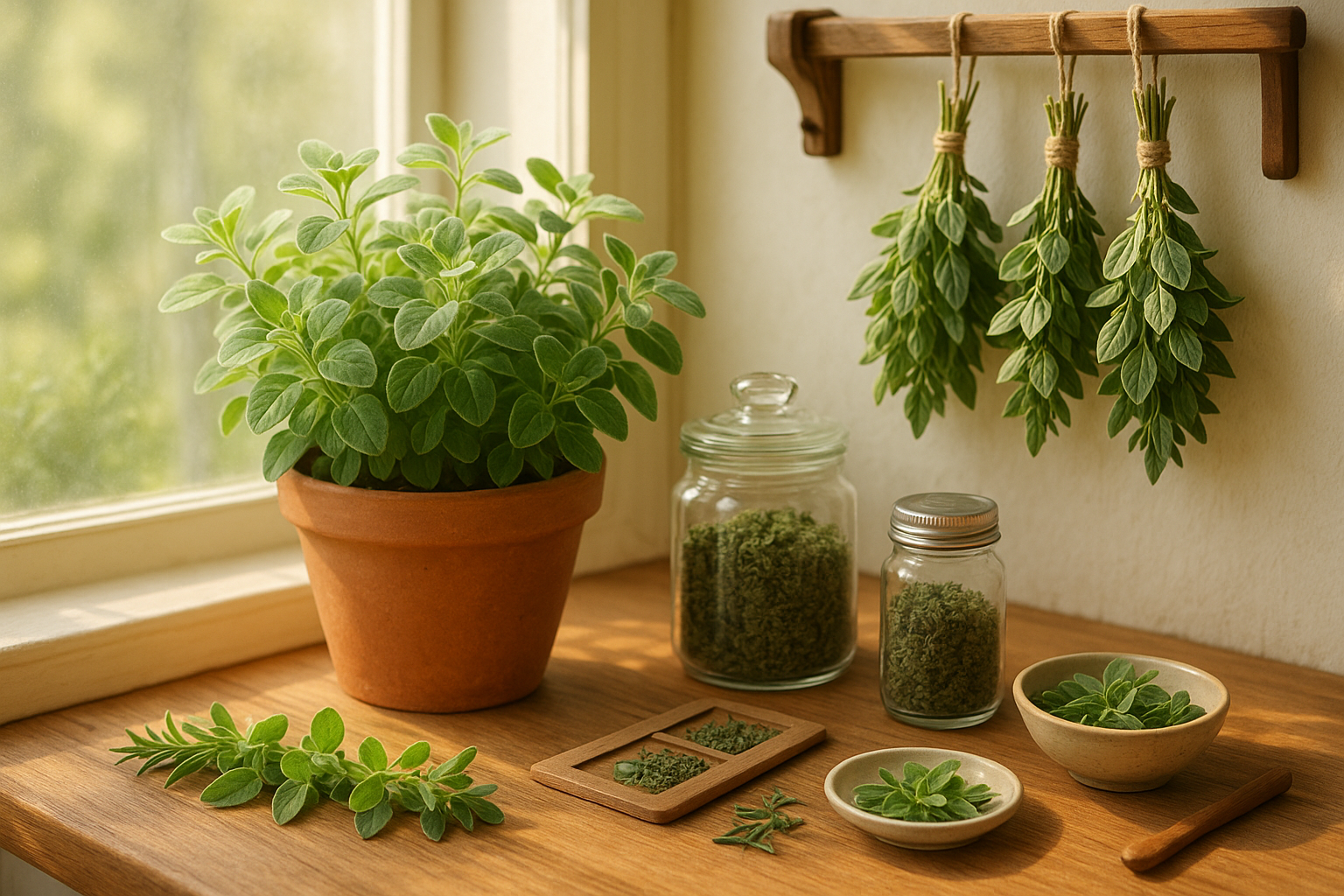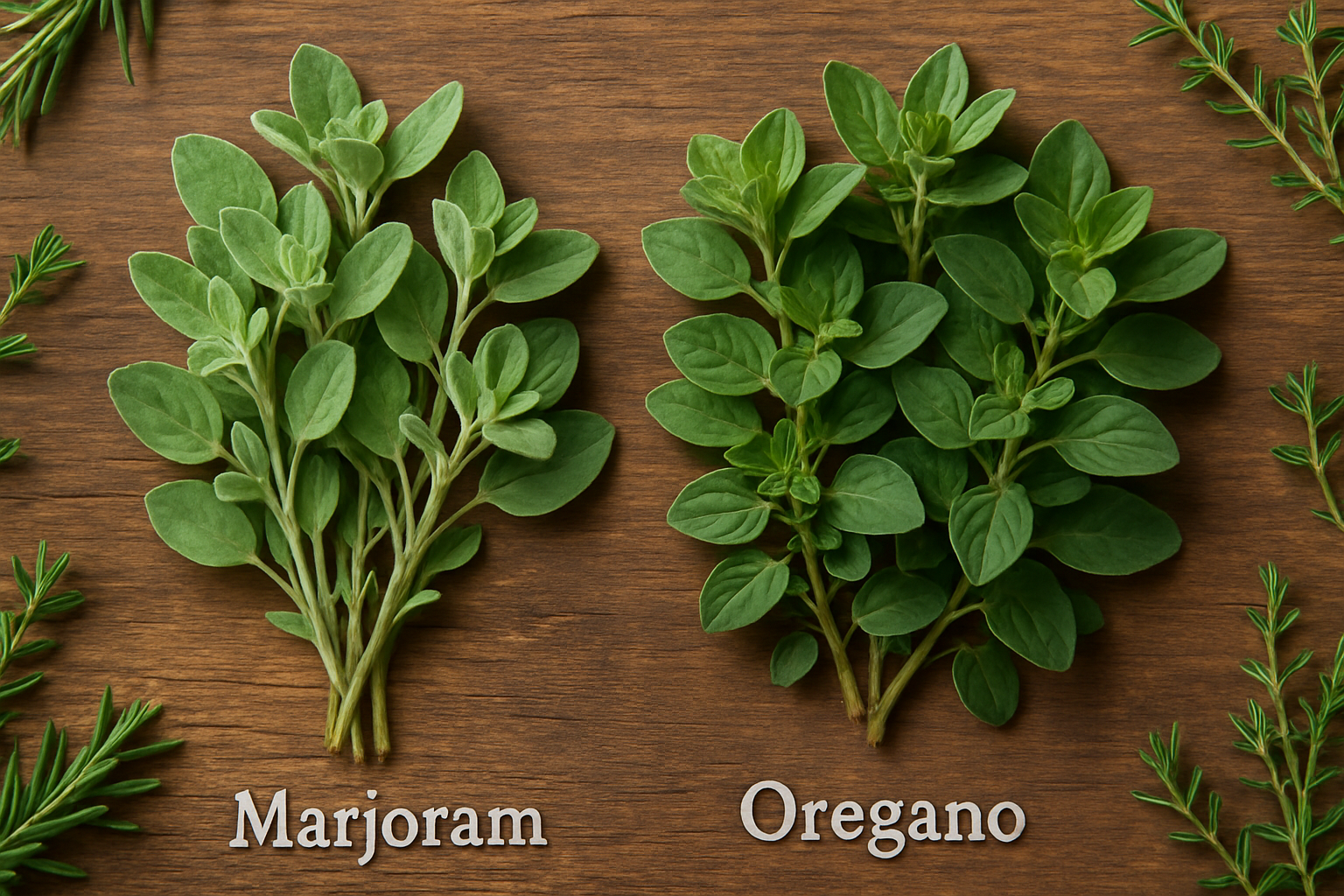Introduction
When it comes to marjoram vs oregano, many cooks and gardeners find themselves curious about the real differences—and why they matter. Both herbs are kitchen and garden staples worldwide, valued for their distinct flavors and versatility. Marjoram, with its sweet and mild taste, often adds a gentle touch to Mediterranean dishes, while oregano is known for its bold, slightly spicy kick, perfect for pizza, sauces, and grilled meats.
This post takes a deep dive into marjoram vs oregano, comparing their flavors, uses, growing habits, and care routines to highlight what sets them apart. Whether you’re looking to elevate your home-cooked meals or select the right plant for your herb garden, understanding these differences can make all the difference. Knowing which herb to use unlocks new flavors in your favorite recipes, and learning their unique care tips gives both beginner and seasoned gardeners the best chance to grow thriving, aromatic plants. If you’ve ever wondered which herb suits your needs—or how to care for each—this guide is packed with practical tips to help you choose wisely and get the most from your herbs.
Marjoram vs Oregano: Botanical Overview

Marjoram (Origanum majorana) and oregano (Origanum vulgare) both belong to the Lamiaceae, or mint family, but their subtle differences have distinguished them in kitchens and gardens worldwide. Marjoram, native to the Mediterranean region, is a tender perennial prized for its mild, sweet flavor. Its oval-shaped leaves are smaller, lighter grayish-green, and often softer to the touch compared to oregano.
Oregano also originates from the Mediterranean but has spread widely across Europe, the Middle East, and the Americas. It grows as a slightly more robust perennial with darker green, larger, spade-shaped leaves that have a coarser texture and a sprawling, bushy growth habit. While the two herbs look similar and are closely related botanically, oregano generally grows taller—up to two feet—whereas marjoram is more compact.
Traditionally, marjoram has been cherished for its delicate flavor in French and Middle Eastern cuisines and was considered a symbol of happiness by the ancient Greeks, often woven into wedding garlands. Oregano became well-known in Italian and Greek cooking, lending its pungent, peppery aroma to pizza and hearty tomato sauces. Beyond their culinary uses, both herbs were valued by ancient civilizations for medicinal purposes, such as soothing digestive issues and serving as antiseptics. The “marjoram vs oregano” debate offers a fascinating blend of botany, tradition, and taste.
Flavor Profiles and Culinary Uses
When comparing marjoram vs oregano, the most striking difference is their flavor profiles. Marjoram offers a delicate, sweet, and almost floral taste, with hints of citrus and pine that add a gentle warmth to dishes without overwhelming them. In contrast, oregano is much more pungent, bold, and peppery, featuring earthy, slightly bitter notes that cut through strong flavors. These distinct characteristics shape their culinary uses around the world.
Marjoram is commonly used in Mediterranean and French cooking, shining in soups, stews, salad dressings, and roasted vegetables. It’s a key ingredient in herbes de Provence and can elevate lighter dishes such as chicken, fish, or sautéed mushrooms. Oregano, often linked to Italian, Greek, and Mexican cuisines, plays a starring role in pizza sauce, tomato-based pastas, grilled meats, Greek salads, and marinades for lamb or beef. Its assertive flavor makes it perfect for hearty and robust recipes, balancing rich cheeses or spicy elements.
Substituting marjoram for oregano can noticeably soften a dish’s taste, making it milder and more subtle—ideal for gentle recipes but potentially lacking the robust punch needed in pizza or chili. Conversely, using oregano instead of marjoram can overpower delicate ingredients, adding a sharpness that might not blend well in lightly seasoned or vegetable-heavy meals. When choosing which herb to use, consider the strength of your other ingredients: reach for marjoram to highlight vegetables, eggs, or gentle proteins, and save oregano for bold, highly seasoned, or tomato-rich dishes.
If a recipe calls for one herb but you only have the other, use a lighter hand with oregano as a substitute for marjoram, and be prepared to add a bit more marjoram to replace oregano’s powerful flavor. This approach helps maintain your dish’s intended balance and keeps it true to its traditional flavor profile.
Growing Conditions: Soil, Sun, and Water Needs
When comparing marjoram vs oregano in terms of growing conditions, it’s important to note that while these Mediterranean herbs are closely related, their preferences differ slightly. Both thrive in well-drained, moderately fertile soil, but oregano is more forgiving and can tolerate poorer soils better than marjoram. Aim for a soil pH between 6.0 and 8.0 for both herbs.
Sunlight is essential: oregano prefers full sun and develops the richest flavor with at least 6-8 hours of sunlight daily. Marjoram also loves full sun but can handle some afternoon shade, especially in hotter climates. Regarding water, oregano is drought-tolerant once established, requiring only occasional deep watering with good drainage to avoid root rot. In contrast, marjoram prefers consistently moist (but not soggy) soil, so regular light watering is best, particularly during dry spells.
In terms of climate, oregano is hardier, thriving in USDA zones 4-9 and able to survive mild winters outdoors with minimal protection. Marjoram is more sensitive, best suited for USDA zones 9 and above; in cooler climates, it’s usually grown as an annual or overwintered indoors. This makes oregano more versatile for outdoor garden beds across various regions.
For container planting, both herbs do well. Containers provide extra protection for marjoram—simply bring pots indoors if frost threatens. Just ensure pots have good drainage and avoid overwatering, especially for oregano. Whether you have a sunny garden plot or a small balcony, both herbs can be robust, flavorful additions as long as their unique preferences are met.
Day-to-Day Care and Maintenance

When it comes to day-to-day care, both marjoram and oregano require similar attention, but knowing a few key differences can help your herbs thrive. Pruning is essential for both plants: regularly pinching back stems encourages bushier growth and prevents legginess. Aim to cut back the top few inches every couple of weeks, especially before the plants flower, to keep them compact and productive.
Marjoram, being milder and more delicate, tends to grow slower and benefits from gentler, more frequent trims. Oregano, on the other hand, can handle more robust harvesting and regrows quickly after a cut. Fertilizing should be minimal for both—overfeeding leads to less flavorful leaves. Usually, an organic, balanced fertilizer once in early spring is enough.
Oregano is more tolerant of poor soil, while marjoram prefers slightly richer conditions, so a compost top-up can support marjoram’s needs. Both herbs thrive in well-draining soil and benefit from watering at the base—avoid wetting the leaves to reduce fungal diseases.
Pest control is rarely a major concern, but keep an eye out for aphids or spider mites. If you spot them, a blast of water or a spray of diluted soap can help keep infestations under control. For even bushier plants, snip flower buds as soon as they appear—this redirects the plant’s energy into leaf production.
With marjoram, harvest leaves lightly but often, since it can become woody if neglected. Oregano thrives with regular, generous picking throughout the growing season. Follow these simple care tips to enjoy a steady supply of fresh, aromatic herbs for your kitchen.
Common Problems and How to Fix Them
When it comes to marjoram vs oregano in the garden, both herbs face similar challenges—but each has its own quirks, too. Aphids and spider mites often target both plants, sucking sap from stems and leaves, which causes wilting and discoloration. You can spot these pests by inspecting new growth for tiny bugs or sticky residue. Washing the plants with a strong spray of water or using insecticidal soap can help control infestations.
Fungal diseases like powdery mildew and root rot also threaten marjoram and oregano, especially in humid conditions or poorly drained soil. To prevent these, ensure your herbs get plenty of airflow, avoid overhead watering, and plant them in well-drained beds or pots. Prune dense patches to improve air circulation, and promptly remove any affected leaves.
Marjoram tends to be more susceptible to cold and overly damp soil, which can cause yellowing leaves and root rot if conditions aren’t ideal. Growing marjoram in raised beds or containers is especially helpful in areas with heavy, wet soil. On the other hand, oregano’s biggest issue is its tendency to become woody and spindly without regular pruning. Frequent harvesting encourages bushier growth and helps keep the plant healthy.
Both herbs can also struggle in nutrient-poor soil. An annual light application of compost or a balanced organic fertilizer can make a big difference. Ultimately, quick attention to pests, careful watering, and consistent pruning will keep marjoram and oregano thriving—whether you’re growing a few pots on your balcony or a full herb patch in your backyard.
Harvesting, Storing, and Preserving
When comparing marjoram vs oregano at harvest time, timing and technique are key to preserving maximum flavor. Both herbs should be picked just before they flower, as this is when their essential oils are at their peak. Choose healthy stems in the morning, after the dew has dried but before the midday sun gets strong. Use sharp scissors or pruning snips to cut above a leaf node, which encourages bushier plants and extends the growing season.
After harvesting, gently rinse the herbs under cool water and pat them dry. For air drying, bundle stems loosely with twine or a rubber band and hang them upside down in a dry, well-ventilated spot out of direct sunlight. This process can take one to two weeks, yielding concentrated flavor. If space is limited, strip the leaves and spread them on a parchment-lined tray, turning occasionally until crisp.
If you prefer to preserve the fresh herb aroma, chop fresh marjoram or oregano leaves and freeze them in ice cube trays with water or olive oil—great for adding directly to soups or sauces. For short-term storage, wrap sprigs in a damp paper towel and place them in a zip-top bag in the fridge; they’ll stay fresh for about a week.
Once fully dried, strip the leaves from the stems, crumble them, and store in airtight glass jars away from light and heat. Avoid plastic bags or containers, as they can cause condensation and reduce potency. By following these steps, you’ll enjoy the distinct flavors of marjoram and oregano in your kitchen for months to come.
Conclusion: Choosing the Right Herb for Your Kitchen and Garden
When comparing marjoram vs oregano, it’s clear that both herbs bring unique strengths to the kitchen and garden. Marjoram is known for its sweeter, milder flavor, making it ideal for lighter dishes, while oregano offers bold, peppery notes that stand out in Italian, Greek, and Mexican recipes.
In the garden, marjoram thrives in warmer, slightly drier soil, whereas oregano is famously hardy and low-maintenance. Both are perennial Mediterranean herbs that do well in sunny, well-drained spots and attract pollinators.
If you prefer subtle, floral seasoning for salads and vegetables, marjoram might be your go-to. But if you want a robust flavor for sauces and roasted meats, oregano won’t disappoint. For most home cooks and gardeners, there’s no need to pick just one—try growing both. Taste-test their flavors in your favorite recipes and discover which herb best complements your style. You might even find some new favorites along the way.
